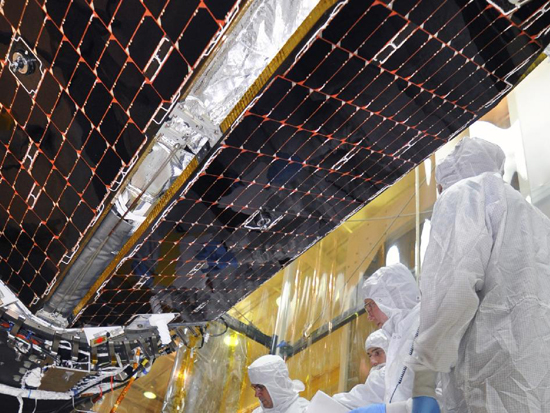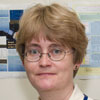Celebrating 50 Years of X-ray Astronomy:
The Present
NASA doesn't work in isolation; it often collaborates with other space science organizations in other countries, helping to share resources and information for everyone's mutual benefit. One example of this is the work with Suzaku. Working from Goddard Space Flight Center, Dr. Koji Mukai helps everyone in the astronomy community use Suzaku by demonstrating the best uses for the equipment, as well as maintaining documentation about software and data products. Mukai also does his own research, which makes it easier for him to help others use the satellite by staying in practice using it himself, and keeping up with the tricks of the trade.

"Over the recent years, we figured out that Suzaku is a very good satellite to study the outskirts of ... clusters of galaxies. In visible light, you would see a bunch of galaxies in the same part of the sky. But the cluster is also filled with X-ray emitting hot gas. For the central part, other X-ray telescopes have done a very good job. But Suzaku has a sensitivity for low surface brightness X-ray emissions from the outskirts. By doing a careful job, we can study the entirety of the cluster, because other missions were studying maybe 1/3 of the mass of the X-ray emitting gas, in the center, where it is brightest. That is important, but if you want the complete picture, you need to go to the outskirts, too. That's where Suzaku has made a big contribution."
Suzaku works in conjunction with Chandra and XMM-Newton. Mukai says that both of those have better angular resolution, and can make better images, which is useful in the central region of a target, where the brightness changes significantly from one part of the sky to the next. But Suzaku is better at the diffuse glow of the X-ray sky.

Astronomers are excited for data from NuSTAR, a new satellite to study cosmic X-rays, launched on June 13, 2012. NuSTAR carries an X-ray imager similar to the one planned for the next Japanese X-ray mission currently in the works, Astro-H. Richard Mushotzky talks about how NuSTAR will lead into Astro-H.

"NuSTAR is a survey-type instrument, used to define what's new and exciting in the hard X-ray bands. With Astro-H, we're going to study them, so we'll have much longer exposures. The main goal of NuSTAR is to go find it, and take a picture, and the main science goal with Astro-H is to study in detail."
Katja Pottschmidt, a member of Goddard's guest observer facility for the Suzaku mission, is excited to see results from NuSTAR. Her main role is to support users of Suzaku data, which she has done in the past for the INTEGRAL and RXTE missions.

"We currently have several active high-energy missions with different and complementary strengths that are all providing exciting results. This has been stated and explained in this year's report of NASA's senior review committee. Personally, I think multi-mission observations often provide the most useful results, either simultaneous observations or using different techniques to answer the same question. A good example is recent spin measurements for black holes in X-ray binaries and active galactic nuclei, which now allows us to determine one of only two measurable and very fundamental properties of black holes.

(Credit: Moritz Boeck, Remeis-Observatory Bamberg / ECAP, FAU, and Univ. Wuerzburg)
The development of new missions is always exciting, since they will provide us with new windows for observing and understanding X-ray sources. I am keen on being able to work with NuSTAR data soon, on observations of several accreting pulsars that show cyclotron line absorption features in their hard X-ray spectra - they can be used to measure the 1012 Gauss magnetic fields of these sources - which NuSTAR will observe with higher sensitivity than ever before. I am also especially looking forward to Astro-H, which will provide the first observations in the soft X-ray band with calorimeter resolution. With Suzaku, Chandra, and XMM, we became much more aware of signatures of the material that is accreted in X-ray binaries and the need for observations with Astro-H, which will combine high spectral resolution and sensitivity, in order to be able to draw firm conclusions, such as how much of each element there is, and whether the material is ionized and/or clumped."
Kimberly Weaver, another Goddard X-ray astronomer, is also looking forward to NuSTAR.

"NuSTAR will open up a new area of research because this is the first time we will be able to take X-ray pictures using the most extreme X-ray energies. Scientists will be able to map out the energetic parts of relativistic jets near black holes, for example."
Publication Date: June 2012


